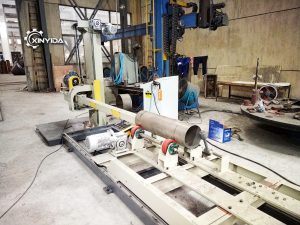Tube polishing machines are essential tools in various industries, including automotive, aerospace, and construction, where they are employed to enhance the aesthetic and functional qualities of metal tubes. The polishing process plays a crucial role in achieving high-quality finishes, improving corrosion resistance, and ensuring parts meet stringent standards. This article will explore how to make better use of tube polishing machines and the advantages of the polishing process, emphasizing best practices for efficiency and effectiveness.
Understanding Tube Polishing Machines
Tube polishing machines are designed to polish and finish the surface of metal tubes and pipes, typically made from stainless steel, aluminum, and other alloys. These machines utilize various techniques, including mechanical polishing with abrasive wheels, belts, or brushes, and chemical polishing to achieve a desired finish.
How to Optimize the Use of Tube Polishing Machines
To get the most out of tube polishing machines, consider the following best practices:
1. Choose the Right Machine for Your Needs
Selecting the appropriate tube polishing machine is crucial for achieving optimal results. Different machines are available based on the tube diameter, length, and material type. Evaluate your specific requirements and choose a machine that best fits your applications. For example, a machine designed for large-diameter tubes will differ from one meant for smaller tubes.
2. Regular Maintenance and Calibration
Routine maintenance and calibration of tube polishing machines are vital to ensure consistent performance. Regularly check and replace worn-out parts, such as polishing wheels and belts, to maintain polishing quality. Additionally, calibrating the machine to ensure it operates at the correct speeds and pressure settings will help prevent inconsistencies in the polishing process.
3. Optimize Polishing Parameters
The polishing process involves several parameters, including speed, pressure, and the type of abrasive material used. Experiment with these parameters to determine the optimal settings for each type of tube and desired finish. For example, adjusting the speed and pressure can significantly impact the quality of the polish, so it’s essential to find the right balance.
4. Use the Right Abrasive Materials
Selecting the appropriate abrasive materials is crucial for achieving the desired finish on metal tubes. Different materials, such as cloth, nylon, or abrasive pads, can produce varying results. For instance, using a finer abrasive material will yield a smoother finish, while a coarser abrasive may be better for removing heavy oxidation or scratches. Always choose abrasives that are compatible with the material being polished.
5. Implement Proper Loading Techniques
Loading the tubes correctly into the polishing machine can significantly impact the effectiveness of the polishing process. Ensure that tubes are securely mounted and aligned properly to avoid vibration during operation, which can lead to uneven polishing. Using fixtures or clamps can help stabilize the tubes and maintain consistency throughout the polishing process.
6. Train Operators Thoroughly
Proper training of machine operators is essential to maximize the efficiency and effectiveness of tube polishing machines. Operators should understand the machine’s functions, maintenance requirements, and best practices for optimizing the polishing process. Regular training sessions can help reinforce proper techniques and introduce new methods to enhance productivity.
7. Monitor Quality Control
Implementing a robust quality control system during the polishing process can help identify issues early and maintain high standards. Regularly inspect polished tubes for defects such as scratches, uneven finishes, or discoloration. By monitoring quality throughout the process, manufacturers can make necessary adjustments to ensure optimal results.
Advantages of the Polishing Process
The polishing process offers numerous advantages across various industries, enhancing both the functionality and appearance of products. Here are some key benefits:
1. Enhanced Aesthetics
One of the most immediate benefits of the polishing process is improved aesthetics. Polished tubes exhibit a bright, shiny finish that is visually appealing, making them ideal for consumer products where appearance matters. Whether in architecture, automotive applications, or home fixtures, a polished finish can enhance product value and appeal.
2. Improved Corrosion Resistance
Polishing can significantly improve the corrosion resistance of metal surfaces. A smoother finish reduces the number of crevices and imperfections where moisture and contaminants can accumulate, decreasing the likelihood of rust and corrosion. This is particularly important in industries such as food processing and pharmaceuticals, where hygiene and material integrity are paramount.
3. Reduced Friction and Wear
Polished surfaces generally exhibit lower friction, resulting in enhanced performance and longevity of mechanical components. In applications involving moving parts, such as machinery and automotive systems, polished surfaces reduce wear and tear, leading to extended operational life and reduced maintenance costs.
4. Better Surface Preparation
The polishing process serves as an effective surface preparation step for subsequent treatments such as plating, coating, or painting. A smooth, polished surface ensures better adhesion of these treatments, leading to improved durability and overall performance of the final product.
5. Increased Value and Marketability
Products with polished surfaces often command higher market prices due to their enhanced appearance and functionality. Investing in tube polishing can provide a competitive advantage, making products more attractive to consumers and potentially increasing profit margins.
Conclusion
Maximizing the use of tube polishing machines involves a combination of selecting the right equipment, optimizing parameters, ensuring proper maintenance, and training operators effectively. By implementing these best practices, manufacturers can enhance the efficiency and effectiveness of their polishing processes. The advantages of polishing, including improved aesthetics, corrosion resistance, and reduced friction, contribute to the overall quality and marketability of products. As industries continue to evolve, investing in advanced polishing techniques will remain a vital component in delivering high-quality, competitive products.

